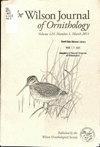Abundance and evidence of reproduction of Wilson's Plover (Charadrius wilsonia) in northeastern Brazil
IF 0.4
4区 生物学
Q4 ORNITHOLOGY
引用次数: 0
Abstract
ABSTRACT The Wilson's Plover (Charadrius wilsonia) has a broad distribution, occurring in a variety of Atlantic and Pacific coastal and island habitats from North America to Peru and Brazil. This shorebird is considered “Vulnerable” in Brazil, but there is little knowledge regarding the species’ reproductive status, abundance, and distribution in South America. We conducted monthly censuses September 2011–September 2012 and January 2016–December 2017 in different habitats of a 10 km beach transect in the Bacia Potiguar region of northeastern Brazil to address this lack of basic information about the species. Our results indicate considerable variation in abundance, with 1–53 individuals/survey, a greater tendency to be found in mudflat habitats, and breeding in June–December. This information will help to recognize the Bacia Potiguar as an important breeding area for Wilson's Plover in Brazil, provide essential baseline knowledge regarding seasonal abundance and reproductive status of this vulnerable shorebird species, and inform conservation planning for this species in the region. RESUMO (Portuguese) A batuíra-bicuda (Charadrius wilsonia) tem uma ampla distribuição, ocorrendo em uma variedade de habitats costeiros e insulares da Costa do Atlântico e do Pacífico, da América do Norte ao Peru e Brasil. Esta ave limícola é considerada “Vulnerável” no Brasil, e existe pouco conhecimento sobre o status reprodutivo, abundância e distribuição da espécie na América do Sul. Realizamos censos mensais de setembro de 2011 a setembro de 2012 e janeiro de 2016 a dezembro de 2017 em diferentes habitats de um transecto de praia de 10 km na região da Bacia Potiguar, no nordeste do Brasil, para suprir essa falta de informações básicas sobre a espécie. Nossos resultados indicam uma variação considerável na abundância, com 1–53 indivíduos/levantamento, com uma maior tendência a ser encontrada em habitats de lama e um período de nidificação entre junho-dezembro. Essas informações ajudará a reconhecer a Bacia Potiguar como uma importante área de reprodução da batuíra-bicuda no Brasil, fornece um conhecimento básico essencial sobre a abundância sazonal e o status reprodutivo dessa espécie vulnerável de ave limícola, e informa sobre o planejamento da conservação dessa espécie na região. Palavras-chave: abundância, espécie vulnerável, reprodução.巴西东北部威尔逊鸻(Charadrius wilsonia)繁殖的数量和证据
威尔逊鸻(Charadrius wilsonia)分布广泛,分布在从北美到秘鲁和巴西的大西洋和太平洋沿岸和岛屿栖息地。这种滨鸟在巴西被认为是“脆弱的”,但人们对该物种在南美洲的繁殖状况、丰度和分布知之甚少。我们于2011年9月至2012年9月和2016年1月至2017年12月在巴西东北部巴基亚波蒂瓜尔地区10公里海滩样带的不同栖息地进行了月度普查,以解决该物种缺乏基本信息的问题。结果表明,黄鳝的丰度变化较大,1 ~ 53只/次,在泥滩生境有较大的分布趋势,6 ~ 12月为繁殖期。这些信息将有助于认识到Bacia Potiguar是巴西威尔逊鸻的重要繁殖区,为这种脆弱的滨鸟物种的季节性丰度和繁殖状况提供必要的基线知识,并为该地区的该物种保护规划提供信息。resume(葡萄牙语)A batuíra-bicuda (Charadrius wilsonia) tem uma ampla distribuial o, ocorrendo em uma varedade de habitats costiros和insulares da Costa do atlantico e do Pacífico, da amacriica do north ao Peru和Brasil。Esta ave limícola考虑到“Vulnerável”在巴西,我们存在一个关于生殖状况的法律框架,在巴西和巴西之间,我们有一个完整的 通讯通讯系统,在巴西和巴西之间。2011年9月、2012年9月、2016年1月和2017年3月在巴西北部的巴西巴基亚波提瓜尔地区的10公里范围内的不同生境中,对不同的生境进行了实地调查,并对informações básicas sobre和espacei进行了分析。Nossos resulttados indicam uma variaal o considerável na ncia, com 1-53 indivíduos/levantamento, com uma major tendência a ser encontrada em habitats de lama e um período de nidificaal o entre junho-dezembro。Essas informações ajudaricao . cn . cn . cn . cn . cn . cn . cn . cn . cn . cn . cn . cn . cn . cn . cn . cn . cn . cn . cn . cn . cn . cn . cn . cn . cn . cn . cn . cn . cn . cn . cn . cn . cn . cn . cn . cn . cn .巴西,cn . cn . cn . cn . cn . cn . cn .巴西,cn . cn . cn . cn . cn . cn . cn . cn . cn . cn . cn . cn . cn . cn . cn . cn . cn . cn . cn . cn . cn . cn . cn . cn . cn . cn . cn . cn . cn . cn . cn . cn . cn . cn . cn . cn . cn。palavras - have: abundance ncia, espcie vulnerável, reproduction o。
本文章由计算机程序翻译,如有差异,请以英文原文为准。
求助全文
约1分钟内获得全文
求助全文
来源期刊
CiteScore
0.90
自引率
0.00%
发文量
133
审稿时长
4-8 weeks
期刊介绍:
Aims & Scope
For more than a century, the Wilson Ornithological Society has published a scholarly journal with form and content readily accessible to both professional and amateur ornithologists. The Wilson Journal of Ornithology is a quarterly publication consisting of major articles based on original studies of birds and short communications that describe observations of particular interest. Each issue also includes reviews of new books on birds and related subjects, as well as ornithological news. Through an endowment from the late George Miksch Sutton, each issue of the Journal includes a full color frontispiece. Each current volume consists of approximately 500 pages. The principal focus of the Journal is the study of living birds, their behavior, ecology, adaptive physiology and conservation.
Although most articles originate from work conducted in the western hemisphere (a large portion of the research on Neotropical birds is published here), the geographic coverage of the journal is global. The Journal is internationally recognized as an important, major journal of ornithology. The Edwards Prize is given annually for the best major article published during the previous year.
The Wilson Journal of Ornithology was formerly named the Wilson Bulletin.

 求助内容:
求助内容: 应助结果提醒方式:
应助结果提醒方式:


